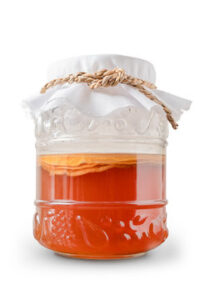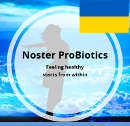Introduction to Types of Foods Containing Live Probiotics
Probiotics, often called friendly bacteria, have stormed the nutritional world owing to their myriad health benefits. While supplements are a popular source, nature’s pantry is indeed replete with a variety of foods packed with live probiotics. This article unravels the types of foods brimming with these beneficial bacteria, nurturing your gut and enhancing overall wellness. So, let’s take a delectable journey and discover the probiotic-rich foods likely sitting in your kitchen right now.
As a side note. I strongly agree that we should eat foods containing live probiotics as often as we can but a modern lifestyle doesn’t allow it. I recommend taking a probiotic supplement, such as Noster Probiotics, daily.
The Probiotic Panorama
In the vast landscape of nutritional wellness, there emerges a vivid panorama where food forms a delightful alliance with friendly bacteria, creating a tableau of enhanced health and gustatory pleasure. This realm, teeming with live probiotics, holds promises of improved gut health, enhanced immune responses, and a sojourn into traditional culinary practices. Are you ready to traverse this probiotic panorama and discover the harmony between taste and health?
A Symphony of Symbiosis
The core essence of probiotics lies in the word itself – ‘pro’, signifying promotion, and ‘biotic’, relating to life. These beneficial microbes, when consumed in adequate amounts, confer a health benefit to the host. Their symbiotic relationship with our bodies, especially our gut, is akin to a well-orchestrated symphony. They tune the gut microbiome, aiding digestion, thwarting harmful microbes, and playing a pivotal role in orchestrating immune responses.
The Historical Tapestry
The narrative of probiotics is woven into the historical tapestry of culinary practices across various cultures. Long before the term ‘probiotics’ was coined, civilizations were reaping the benefits of fermented foods laden with beneficial bacteria. From the tangy allure of sauerkraut in Germany to the spicy zest of kimchi in Korea, the global culinary narrative is peppered with probiotic-rich foods, each telling a tale of traditional wisdom and communal wellness.
The Modern-Day Quest
Today, as we stand on the cusp of nutritional enlightenment, the quest for natural probiotic sources has been rekindled. Amidst the cacophony of synthetic supplements, the serene and subtle whispers of natural probiotic-rich foods beckon. They not only offer a cornucopia of live beneficial bacteria but also provide a sensory delight with their diverse tastes and textures.
The Culinary Voyage
Embarking on this culinary voyage, you’ll be navigating through the types of foods containing live probiotics, from the creamy realms of yoghurt and kefir to the spicy shores of fermented vegetables, and the uncharted waters of fermented beverages and grains. Each morsel offers not just a taste adventure but a step towards holistic wellness.
As we delve deeper into the types of foods teeming with live probiotics, you will uncover that this journey is not merely about satiating the taste buds, but about nurturing the body, celebrating age-old culinary traditions, and embracing the natural symbiosis that promises a vibrant health. So, are you ready to explore the probiotic panorama and indulge in a banquet of beneficial bacteria?
Fermented Dairy Delights
Dairy has been a staple in many diets around the globe for centuries. However, when fermentation waltzes in, it morphs this everyday staple into a treasure trove of probiotics, enhancing its nutritional profile and making it a cornerstone for a healthful diet. Let’s delve into two of the most celebrated fermented dairy delights: yoghurt and kefir.
Yoghurt: A Classic Probiotic Powerhouse
Yoghurt, the quintessential representative of probiotics, is where the journey of many into the realm of probiotic foods begins. This lusciously creamy concoction emerges from a simple yet magical process – the fermentation of milk induced by the symbiotic action of Lactobacillus bulgaricus and Streptococcus thermophilus. These bacterial maestros orchestrate a transformation not just in texture and taste but amplify the health quotient of the humble milk.
The result is a delightful creamy pot teeming with a community of friendly bacteria ready to colonise your gut, promoting a harmonious digestive rhythm. The beneficial bacteria in yoghurt are known for their prowess in alleviating digestive discomfort, reducing the duration of certain gastrointestinal infections, and potentially lessening the severity of conditions like irritable bowel syndrome (IBS).
Moreover, the tale of yoghurt doesn’t end at probiotics. It’s a nutritional virtuoso, belting out tunes of high-quality protein, vital vitamins like B12 and D, and essential minerals such as calcium and phosphorus. It’s no wonder why yoghurt enjoys a revered status in the health and wellness community.
But, the narrative gets more colourful as yoghurt embraces various cultures, quite literally! From the thick and creamy Greek yoghurt to the zesty zest of Bulgarian yoghurt, the variety is as diverse as the probiotic strains they host. Each spoonful promises a venture into a new cultural anecdote, making yoghurt a global ambassador of probiotics.
Kefir: A Tangy Probiotic Beverage
Now, let’s traverse from the creamy terrains of yoghurt to the slightly effervescent, tangy realms of kefir. This cherished beverage has its roots in the Caucasus Mountains, where it was traditionally believed to be a gift from the gods due to its health-promoting properties.
Kefir is crafted through a fascinating fermentation ballet, where the kefir grains – a symbiotic colony of bacteria and yeasts – dance through milk, fermenting the lactose to yield a beverage rich in probiotics, yeasts, vitamins, minerals, and bioactive compounds. The microbial diversity in kefir often surpasses that of yoghurt, hosting a myriad of beneficial bacteria and yeasts ready to confer a plethora of health benefits.
The journey of a sip of kefir through your system is like a rejuvenating spring cleaning for your gut. It helps in improving digestive health, bolstering the immune system, and may even exhibit anti-inflammatory and anti-cancer properties.
Its tantalizing tanginess is not just a delight for the palate but an invitation to explore the probiotic grandeur it offers. Whether enjoyed plain, infused with fruits, or used as a base in smoothies and salad dressings, kefir is a versatile, nutrient-dense, and probiotic-rich beverage that promises a delectable and healthful indulgence.
In the grand tapestry of probiotic foods, yoghurt and kefir are like two illustrious threads weaving through, enriching our diets with their unique textures, tastes, and troves of beneficial bacteria. As we delve deeper into the world of fermented dairy delights, the narrative of health, tradition, and culinary exploration unfolds beautifully, promising a nourishing adventure in every spoonful or sip.
Fermented Vegetables: A Tale of Tang and Tradition
Vegetables, the humble residents of our kitchens, undergo a remarkable transformation under the spell of fermentation. This age-old culinary practice, revered across cultures, transforms the crunchy greens (and reds and yellows) into a powerhouse of probiotics and a carnival of complex flavours. The epitome of this transformation finds expression in two globally cherished preparations – Sauerkraut from the heart of Germany and Kimchi from the soul of Korea.
Sauerkraut: A German Tradition
Sauerkraut, with its humble beginnings in the heartlands of Germany, is a beautiful rendition of fermented cabbage. Its name, a melodious blend of ‘sour’ (Sauer) and ‘cabbage’ (kraut), is a straightforward descriptor of what one can expect – a tangy crunch that enlivens the palate. However, the simplicity of its name belies the richness of its tradition and health benefits.
As the fresh cabbage commingles with salt in a carefully orchestrated fermentation dance, culinary alchemy occurs. Over time, the natural bacteria present on the cabbage leaves ferment the sugars in the cabbage, resulting in a tangy, pickled delight teeming with live probiotics, primarily Lactobacillus bacteria. This microbial army is not only beneficial for gut health but also a sentinel for your immune system.
The tang of sauerkraut is not merely a taste sensation; it’s a herald of the nutritional bounty it carries. Rich in dietary fibres, vitamins C and K, and essential minerals like iron and manganese, sauerkraut is a simple yet potent addition to meals. Its traditional presence on the German table transcends the taste barrier and ventures into the realm of healthful living, making it a cherished tradition passed down through generations.
Kimchi: Korean Fermented Veggies
Now, let’s traverse the culinary globe to land in Korea, where the spicy, fermented marvel called Kimchi reigns. Kimchi is not merely a dish; it’s a reflection of Korea’s rich culinary tradition and a testimony to human ingenuity in food preservation.
At its core, Kimchi is a spicy, fermented vegetable preparation, with napa cabbage and Korean radishes being the primary stars, adorned by a medley of spices and seasonings like chilli pepper, garlic, ginger, and jeotgal (salted seafood). The fermentation process, under the aegis of various lactic acid bacteria, not only amplifies its taste but imbues it with a rich probiotic profile.
Each bite of Kimchi is a rendezvous with a spicy crunch that hosts a colony of beneficial microbes, most notably Lactobacillus kimchii. These friendly bacteria wade through your digestive tract, promoting gut health, aiding digestion, and potentially warding off several ailments.
Moreover, Kimchi is a nutritional dynamo, boasting a rich supply of vitamins A, B, and C, and essential minerals. Its regular presence in Korean meals is not just a nod to its taste, but a homage to its health-promoting attributes.
A Culinary Bridge Between Cultures
Sauerkraut and Kimchi, though sprung from different cultural soils, share a common thread of fermentation, showcasing the beautiful tapestry of traditional culinary practices. They bridge the gap between taste and health, offering a unique, probiotic-rich, flavourful journey from the bustling kitchens of Germany to the serene culinary landscapes of Korea. Through the veil of time, these fermented wonders have carried the legacy of their respective cultures, narrating tales of tradition, survival, and the indomitable human spirit of culinary exploration.
Fermented Soy Products: A Voyage from Indonesia to Japan
The humble soybean, when embraced by the ancient art of fermentation, transcends its modest origins to become a cornerstone of culinary traditions in many Asian cultures. Through a tapestry of techniques and traditions, fermented soy products like Tempeh and Miso have emerged as both nutritional powerhouses and culinary delights. Let’s traverse this fascinating journey from the lush archipelago of Indonesia with Tempeh to the serene islands of Japan with Miso.
Tempeh: A Protein-rich Soy Product
In the heart of Indonesia, a country known for its vibrant culture and diverse culinary palette, tempeh has been a staple food for centuries. This unique food is born when whole soybeans undergo a fermentation process under the gentle care of a specific type of fungus known as Rhizopus oligosporus. The result is a firm, cake-like product that holds a special place in both the kitchens and the hearts of the Indonesian people.
The fermentation not only binds the soybeans together but elevates their nutritional profile, making tempeh a protein-rich boon for vegetarians and vegans alike. It’s a whole food source of plant protein, providing all the essential amino acids that the body requires, making it a rare gem in the plant-based world.
Moreover, tempeh is a hospitable host to a variety of probiotic microorganisms that promote digestive health. The fermentation process also significantly reduces the levels of anti-nutrients in soybeans, enhancing the body’s absorption of minerals like iron, calcium, and zinc.
But the tale of tempeh isn’t just a narrative of nutrition. Its nutty flavour and satisfyingly chewy texture make it a versatile ingredient that can be grilled, sautéed, or crumbled into various dishes, carrying a piece of Indonesian tradition to plates worldwide.
Miso: A Staple in Japanese Cuisine
Let’s now sail to the serene shores of Japan, where miso, a traditional seasoning, has been adding depth of flavour and health benefits to the Japanese diet for centuries.
Miso is a paste born from a meticulous process of fermenting soybeans with salt and a fermentation culture known as koji (Aspergillus oryzae). This trio of ingredients, under the tender nurture of time, transforms into a paste that holds the essence of umami, the fifth basic taste often described as savoury.
The probiotic-rich nature of miso stems from the living microorganisms that thrive during its fermentation process. These friendly microbes, chiefly Lactobacillus strains, embark on a journey through the digestive tract once consumed, promoting a healthy gut flora and aiding in digestion.
But Miso’s offering doesn’t end at probiotics. It is a nutritional goldmine, housing a spectrum of B vitamins, essential minerals, and plant compounds like isoflavones and saponins that may benefit heart health.
Miso’s culinary versatility is as profound as its nutritional richness. It’s the cornerstone of the Japanese culinary tradition, lending its savoury warmth to a plethora of dishes like miso soup, marinades, and glazes, making the cuisine not just a feast for the taste buds but a nourishing banquet for the body.
The Cultural Tapestry of Fermented Soy
The tales of tempeh and miso, though rooted in different cultural soils, intertwine in the grand narrative of fermented soy, showcasing the beautiful interplay between culture, tradition, and the boundless potential of a simple bean through the lens of fermentation. These cherished foods are not just carriers of taste and nutrition, but vessels of age-old wisdom and culinary heritage that continue to nourish bodies and souls across the globe.
Beverage Bonanza: A Toast to Health and Tradition
Amidst the myriad of beverages that flood the modern market, there stand a few that trace their lineage back to ancient traditions, carrying with them not merely the taste of times gone by, but the whispers of ancestral wisdom and the gentle touch of nature’s nurture. In this venture, we’ll traverse the expanse from the ancient tea gardens of Northeast China with Kombucha to the rustic kitchens of Slavic and Baltic regions with Kvass, exploring the tradition, taste, and therapeutic charm these fermented beverages carry within their brew.
Kombucha: The Ancient Chinese Drink
Kombucha, often dubbed the “Immortal Health Elixir” by the Chinese, has its roots entrenched in Northeast China around 220 B.C. The legend of its health benefits has trickled through centuries and civilizations, making Kombucha a revered beverage across the globe today.
health benefits has trickled through centuries and civilizations, making Kombucha a revered beverage across the globe today.
At its core, Kombucha is a concoction of tea, sugar, and a symbiotic colony of bacteria and yeast (SCOBY). As the tea and sugar brew marries the SCOBY, a fermentation saga unfolds, leading to the birth of a tangy, mildly alcoholic, effervescent beverage. The tale of taste doesn’t end here; the flavour of Kombucha can be further nuanced with a variety of fruits, herbs, and spices during a second fermentation process, making it a versatile beverage that caters to a palette of taste preferences.
The star of Kombucha’s narrative, however, is the probiotic battalion it hosts. The live microbial culture, predominantly consisting of Gluconacetobacter species, synergizes with the organic acids and bioactive compounds created during fermentation to offer a spectrum of health benefits. From potentially enhancing gut health and boosting immune function to possibly reducing the risk of chronic diseases, the lore of Kombucha’s health benefits continues to entice and evolve.
Kvass: Russian Probiotic Brew
Now, let’s journey to the colder climes of the Slavic and Baltic regions, where Kvass, a cherished traditional beverage, warms the hearts and hearts. Kvass traces its lineage back to ancient Slavic and Baltic cultures where it was a household staple, revered not just for its taste but for its nutritional and probiotic merits.
The humble beginnings of Kvass are rooted in old bread, usually rye or barley, which embarks on a fermentation voyage with water, yeast, and often a medley of ingredients like fruits, berries, and herbs. As the brew ferments, it transforms into a mildly alcoholic beverage with a taste reminiscent of beer but with a unique tang and sweetness.
The modest alcohol content of Kvass doesn’t overshadow its probiotic prowess. The fermentation process encourages the proliferation of beneficial microbes like Lactobacillus species, which are known to promote gut health and boost the immune system.
Kvass is not merely a beverage; it’s a gulp of tradition, a sip of community camaraderie, and a toast to the simple yet profound wisdom of ancient food practices.
A Fusion of Cultures in a Gulp
The tales of Kombucha and Kvass, though separated by continents and cultures, converge at the essence of traditional fermented beverages. They are a testimony to humanity’s age-old symbiosis with nature’s microscopic world, showcasing a blend of culinary heritage, taste adventure, and the timeless quest for health and wellness. Each sip is not just a taste experience, but a voyage through time and tradition, a narrative of human ingenuity, and a salute to the profound simplicity of ancient culinary wisdom.
Grain-based Probiotics: The Sourdough Saga
In the grand narrative of culinary traditions, the tale of bread holds a special chapter. Bread, in its myriad forms, has been a cornerstone of diets across cultures and continents. However, amidst the plethora of bread varieties, sourdough stands out with a distinctive character, a unique fermentation story, and a deep-rooted history that dates back to ancient civilizations. Let’s knead through the narrative of sourdough bread, exploring its creation, character, and contributions to health.
The Birth of a Loaf: A Natural Fermentation Fable
Sourdough bread’s unique identity is crafted in the cradle of a natural fermentation process. Unlike conventional breads that employ commercial yeast for leavening, sourdough relies on a symbiotic community of naturally occurring lactobacilli and wild yeasts. This community, often referred to as a sourdough starter, is nurtured over time with just flour and water, evolving into a potent leavening agent that’s capable of giving rise to a loaf of bread.
The fermentation journey of sourdough is a slow, deliberate dance between the microbes and the dough. As the wild yeasts diligently convert the carbohydrates in the dough into carbon dioxide, giving the bread its rise, the lactobacilli orchestrate the creation of lactic acid, which imparts the characteristic tang to sourdough bread.
A Texture and Taste Adventure
The result of this microbial camaraderie is a loaf with a hearty crust, a tender, chewy crumb, and a tangy personality that sets it apart from its bread brethren. The flavour profile of sourdough is not merely a taste delight; it’s a narrative of the natural fermentation process, a tale told with each tangy bite. Its texture adds a rustic, hearty character to sandwiches, toasts, and a myriad of culinary creations, making it a cherished choice for those seeking bread with both substance and soul.
A Nutritional and Probiotic Prodigy
But sourdough isn’t just a taste titan; it’s a nutritional and probiotic prodigy. The fermentation process it undergoes enhances its nutritional profile and digestibility. The diligent work of lactobacilli and yeasts breaks down phytic acid, an antinutrient that can inhibit the absorption of essential minerals like iron, zinc, and calcium. This makes the minerals in sourdough more bioavailable compared to conventional breads.
and digestibility. The diligent work of lactobacilli and yeasts breaks down phytic acid, an antinutrient that can inhibit the absorption of essential minerals like iron, zinc, and calcium. This makes the minerals in sourdough more bioavailable compared to conventional breads.
The probiotic presence, though not surviving the baking process, leaves behind a legacy of organic acids and bioactive peptides that can have beneficial impacts on gut health and metabolic processes. Moreover, the lactic acid bacteria can also contribute to a lower glycaemic index, making the release of sugar into the bloodstream slower, which is a healthier option for managing blood sugar levels.
A Legacy of Loaves
Sourdough is more than just a loaf of bread; it’s a legacy of ancient baking traditions, a celebration of microbial marvels, and a testament to the simplicity and brilliance of natural fermentation. Each slice carries within it the whispers of ancient baker’s wisdom, the patience of natural processes, and the promise of a nourishing, satisfying reprieve from the hurried, synthetic shortcuts of modern food practices. In a world chasing speed and shortcuts, the slow, deliberate creation of sourdough bread stands as a humble, hearty homage to the timeless virtues of patience, tradition, and nutritional wisdom.
Tackling Probiotic Challenges
While embracing the types of foods containing live probiotics, one might encounter challenges like finding the right source or dealing with initial digestive discomfort. However, with a gradual introduction and choosing the right probiotic foods that suit your palate and body, you can effortlessly incorporate them into your diet.
Summary
The realm of probiotics is vast, with a plethora of foods offering a natural source of these beneficial bacteria. From dairy delights to fermented veggies and beverages, the options are endless. Embarking on this probiotic journey not only tantalizes the taste buds but significantly contributes to better digestive health.
FAQs
1. What are some other sources of probiotics?
- Besides the commonly known sources like yoghurt, kefir, sauerkraut, kimchi, kombucha, kvass, and sourdough bread, other probiotic-rich foods include:
- Traditional Buttermilk: The type that contains live cultures.
- Pickles: Fermented with natural lactic acid bacteria.
- Cheese: Varieties like Gouda, mozzarella, cheddar, and cottage cheese which are fermented and contain live cultures.
- Fermented Soy Products: Like natto and miso.
- Fermented Meats: Such as salami and chorizo, though these should be consumed in moderation.
2. How to incorporate probiotic foods into your daily diet?
- Start Slow: Introduce probiotic foods gradually to allow your gut to adjust.
- Diversify: Include a variety of probiotic foods to benefit from different strains of beneficial bacteria.
- Pair Wisely: Combine probiotic-rich foods with prebiotic foods like bananas, onions, and garlic that feed the beneficial bacteria.
- Snack Smart: Substitute common snacks with probiotic-rich alternatives like yogurt or pickles.
- Cook Creatively: Use miso in soups, tempeh in stir-fries, or create a sourdough pizza base to add a probiotic punch to your meals.
3. Can I get enough probiotics from food alone?
- It’s possible to obtain a beneficial amount of probiotics from a well-rounded diet rich in fermented foods. However, the exact amount of probiotics one needs can vary based on individual health conditions, age, and dietary restrictions. Consulting with a healthcare professional can provide personalized advice.
4. Are there any side effects of consuming probiotic foods?
- Probiotic foods are generally safe for most people. However, individuals with compromised immune systems or severe intestinal diseases should exercise caution. In some cases, consuming probiotic foods may cause mild side effects like gas and bloating, especially when introduced in large amounts suddenly.
5. How to choose the best probiotic food for my dietary needs?
- Identify Dietary Restrictions: Choose probiotic foods that align with any dietary restrictions or allergies you may have.
- Diversify: Aim for a variety of probiotic foods to benefit from different bacterial strains.
- Quality Matters: Opt for high-quality, preferably organic, and traditionally fermented products.
- Read Labels: Look for labels indicating live active cultures and avoid products with high sugar or artificial preservatives.
- Consult a Professional: Seek advice from a healthcare professional or a nutritionist to identify the probiotic foods that best meet your health needs.
These FAQs provide a pathway to better understanding and incorporating probiotics into your daily regimen, paving the way towards improved gut health and overall wellness.

